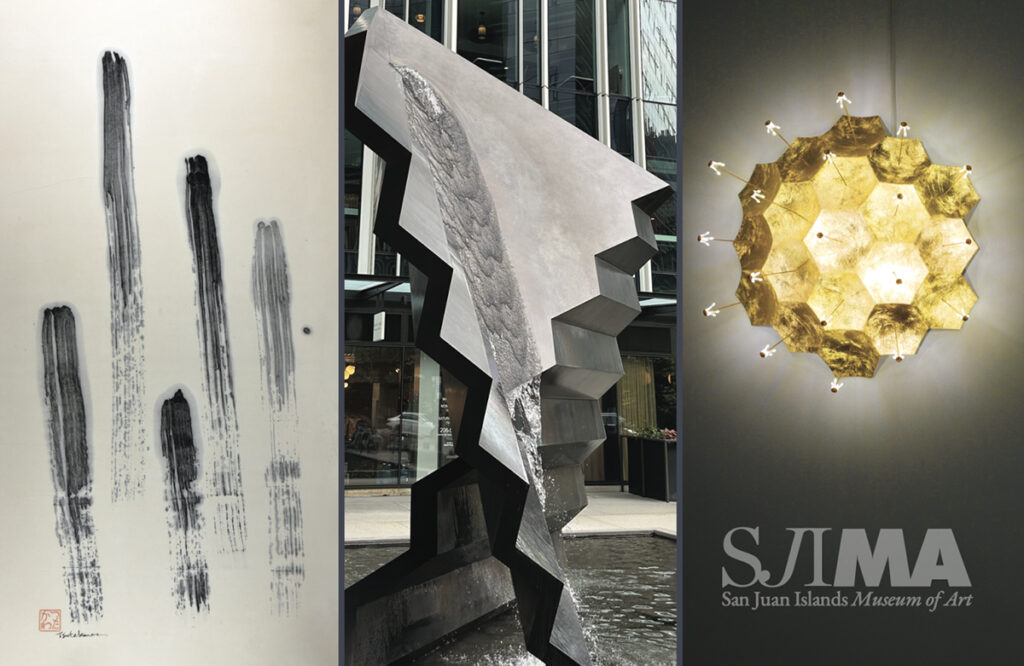By Andrew Hamlin
NORTHWEST ASIAN WEEKLY
Most Asian Americans and most art collectors know the name of George Tsutakawa, who lived from 1910 to 1997 and spent most of his life in his native Seattle.
Tsutakawa painted and made prints, but he’s best known for his long career making and installing large sculptures, including the “Fountain of Wisdom,” located outside the Seattle Central Library; and “Heaven, Man, Earth” at South Jackson and Maynard in the Chinatown-International District.
He’s one of the best-known and best-loved sculptors Seattle’s ever produced. But up until recently, his work was never featured in a show alongside both the work of his son, sculptor Gerard Tsutakawa, and his grandson, Kenzan Tsutakawa-Chinn, who works with light installations.
“The initial plan was to offer Gerard an exhibition,” explained Peter Lane, at the San Juan Island Museum, about its current exhibit “Tsutakawa: Generations—A Flow of Water, Form, and Light.”

Gerard Tsutakawa, born in 1947, remembers growing up with his famous father, and around creativity.
“In 1955, we moved to the house where my father did most of his work,” remembers the son. “I remember his wood carving that happened in the basement. We traveled together in the 1960s to Europe together to see art.
“My father didn’t really instruct me in art or sculpture. He taught by example, showing how his designs and fountains were built. After doing sculptures for 50 years, I think my work has evolved to be clearer and more confident. I don’t have a lot to prove to myself so it has become easier to design and build in 3D.”
Asked to compare and contrast George Tsutakawa’s output with that of his son and grandson, Peter Lane said, “Gerard’s work is uniquely his own through form, process, and craftsmanship. He incorporates angular shapes into grounded forms, flowing with movement.
“Like his uncle and grandfather, Kenzan works with movement. The two generations before Kenzan explore the flow of water. Kenzan is doing the same, only with light.”
For his part, Kenzan Tsutakawa-Chinn relates that he’s been working with light going back to graduate school, where he began to incorporate LED (light-emitting diodes) into his works.
“It was a fascination with light as a natural medium. [Light] only takes suggestions on how to act, it’s not an exact science. There’s a bit of a conversation with the media, to get what you want. It’s an aesthetic and scientific challenge.”
Peter Lane says the three Tsutakawas form a conceptual through-line in their work combined.
“Gerard apprenticed with George, so it is very easy to see the influence. Looking at Gerard’s overall body of work, one can see where he branches out to find his own voice.
“While Kenzan appears to be branching out, and is, still his work is interconnected with the use of soft curves and geometric shapes.”
The curation and selecting of specific pieces took place mostly at Gerard Tsutakawa’s home.
“The process included the family,” said Lane. We selected pieces I felt were important examples of different eras of George’s influences, such as oil paintings and furniture from the 1950s, bronze sculpture from the 1960s , and sumi ink paintings from the 1970s. It was a similar process with Gerard, although with the benefit of being able to incorporate pieces he specifically wanted to include.
“Our facility isn’t large enough to have an installation of Kenzan’s. However, we were able to incorporate some of his wall pieces which were an introduction to the work he is currently focused on.”
Lane says he hopes the exhibit highlights the influence of the Tsutakawas on art over the course of 80 years and more.
“In my opinion, they are the most influential creatives, as a family on the whole, to this region.”
“Tsutakawa: Generations—A Flow of Water, Form, and Light” runs through Sept. 16 at the San Juan Islands Museum of Art, located at 540 Spring Street in Friday Harbor.
For prices, hours, and other information, visit https://www.visitsanjuans.com/eventdetail/72551/tsutakawa-generations-a-flow-of-water-form-and-light-.